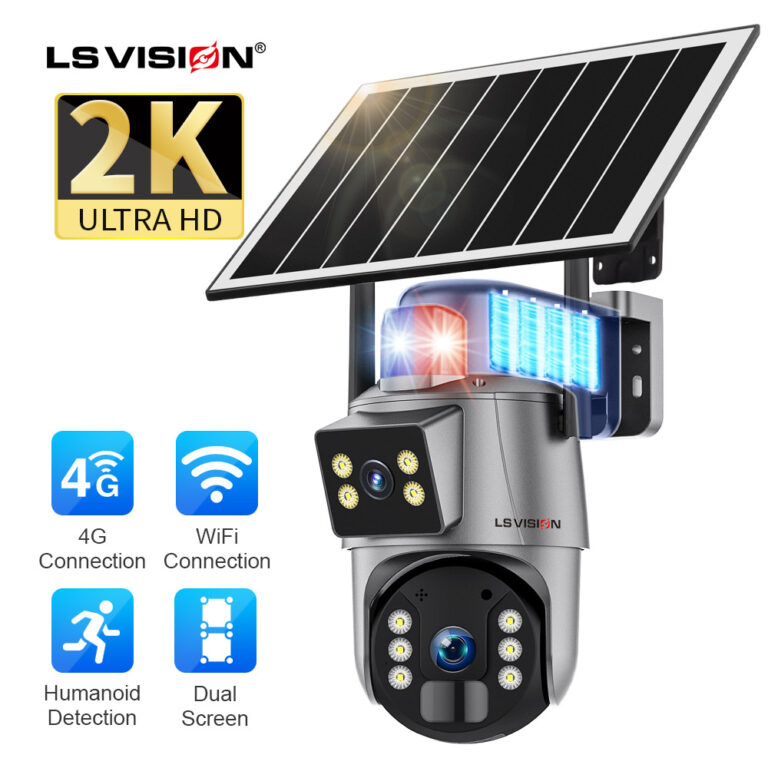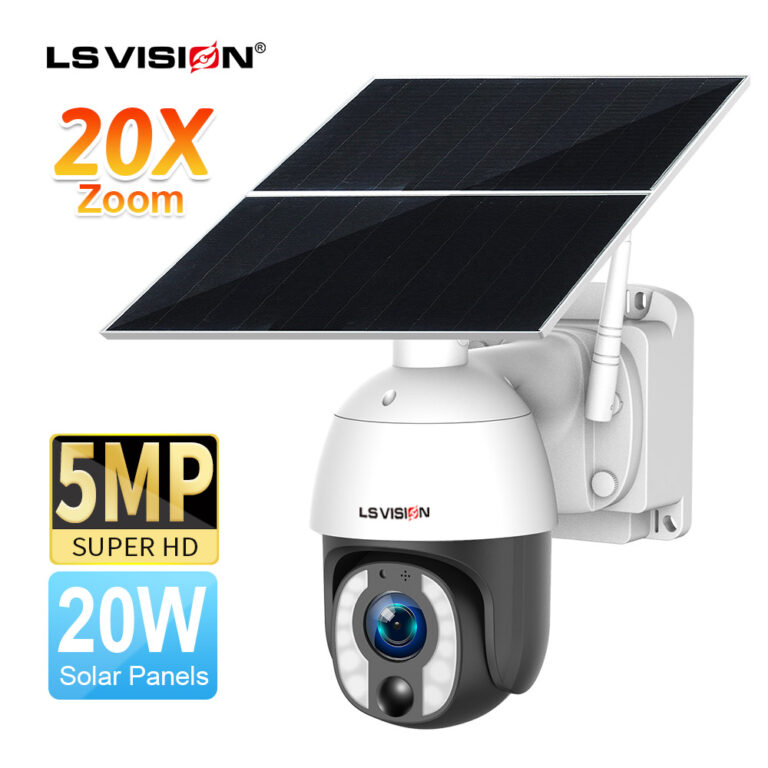The global market for solar-powered CCTV security cameras is rapidly expanding, driven by the growing demand for renewable energy and improved security solutions. These advancements have made solar camera systems more affordable, efficient, and essential for modern surveillance needs.
Whether in rural regions or urban centers, security camera solar wireless solutions are reshaping the way we approach safety and sustainability. In this blog, we will explore emerging markets, growth factors, and the transformative impact of solar cameras on global security.
- Remote and Rural Areas: One of the most significant markets for solar-powered CCTV security cameras is remote and rural areas with little or no access to grid electricity. These regions benefit immensely from solar camera systems, which provide reliable surveillance without requiring traditional power sources. Homeowners can monitor their properties from anywhere, ensuring safety even in the most isolated locations.
- Off-Grid Properties: Off-grid properties, including vacation homes, cabins, and farms, are increasingly adopting solar cameras. These systems offer peace of mind by allowing property owners to keep an eye on their assets remotely. Even in the absence of electricity, solar-powered CCTV security cameras maintain 24/7 vigilance.
- Eco-Conscious Households: The growing emphasis on environmental sustainability is driving eco-conscious homeowners to invest in solar cameras. These systems align perfectly with green initiatives, offering a carbon-neutral, energy-efficient alternative to traditional surveillance systems.
2. Commercial Applications

- Remote Construction Sites: Construction sites often face challenges in securing reliable power for surveillance systems. Solar camera systems provide an efficient and cost-effective solution for monitoring construction activities, deterring theft, and ensuring worker safety. With wireless connectivity, they are perfect for dynamic environments where constant relocation may be required.
- Agricultural and Livestock Monitoring: Farmers are increasingly adopting security camera solar wireless solutions to monitor livestock and secure their farms. These cameras help track animal movements, deter intruders, and manage resources effectively. Their ability to function independently in vast rural areas makes them indispensable in modern agriculture.
- Wildlife Conservation: Wildlife sanctuaries and conservation organizations are using solar camera systems to track animal behaviour, monitor populations, and detect potential threats like poaching. These cameras can withstand harsh environments, providing valuable data in even the most remote locations.
3. Government and Public Sector
- Border and Coastal Security: Solar cameras are becoming a critical tool for monitoring borders and coastlines. Their durability and ability to operate in extreme weather conditions make them ideal for detecting illegal activities and securing vital infrastructure.
- Traffic Monitoring and Law Enforcement: In urban areas, solar-powered CCTV security cameras are integrated into traffic monitoring systems to improve road safety and manage traffic flow. Law enforcement agencies also use these cameras to identify violators and maintain public order.
- Environmental Monitoring: Governments and environmental organizations are employing solar cameras to monitor ecosystems, track wildlife populations, and detect pollution. These systems provide essential data for policymaking and conservation efforts.

- Remote Industrial Sites: Industrial operations in remote areas, such as oil rigs, mining sites, and power plants, require robust surveillance systems. Solar-powered CCTV security cameras are the perfect fit, providing reliable monitoring in areas without grid power. They ensure worker safety and secure valuable assets.
- Infrastructure Monitoring: Critical infrastructure, such as bridges, dams, and pipelines, can be effectively monitored using solar cameras. These systems help detect wear and tear, preventing costly repairs and ensuring public safety.
- Logistics and Supply Chain Management: Warehouses, distribution centres, and transportation routes benefit from solar cameras, which improve security and streamline operations. Their wireless connectivity and real-time monitoring capabilities make them an asset for the logistics sector.
Key Factors Driving the Growth of Solar Cameras
- Technological Advancements: Innovations in solar panels, battery storage, and camera technology are enhancing the performance and affordability of solar camera systems. Manufacturing advancements, similar to those seen in the broader solar industry, have drastically reduced costs, making solar cameras more accessible.
- Cost-Effectiveness: Declining solar component prices and improved energy efficiency make solar cameras a cost-effective alternative to traditional surveillance systems.
- Environmental Sustainability: Solar cameras align with global efforts to reduce carbon footprints, offering a green solution for security needs. With the solar market expanding rapidly, solar technologies will continue to provide transformative solutions for security systems.
- Wireless Connectivity: Reliable 4G and 5G connectivity enable seamless data transmission, making security camera solar wireless solutions more practical than ever.
- Advanced Features: Modern solar cameras come equipped with HD video, night vision, motion detection, and remote access, making them versatile for various applications.
Challenges and Opportunities
Challenges:
- Weather Dependence: Limited sunlight during cloudy or rainy days can affect performance, but advancements in battery technology are mitigating this issue.
- Installation and Maintenance: Proper installation requires specialized expertise, but growing awareness is bridging this gap.
- Data Security: Ensuring data privacy and implementing robust encryption protocols is critical.
Opportunities:
- AI and Machine Learning: Integrating AI capabilities can enhance object recognition and event detection.
- IoT Integration: Connecting solar cameras with IoT devices can create comprehensive security ecosystems.
- Customizable Systems: Developing modular systems will allow users to tailor solutions to their needs.
Conclusion
The emerging markets for solar cameras in 2025 and beyond span residential, commercial, government, and industrial sectors. As technology advances and the demand for sustainable security solutions grows, solar-powered CCTV security cameras are set to redefine surveillance worldwide. With the global solar market projected to grow significantly, the integration of solar technologies into security systems is poised to play a transformative role.
Take the next step toward sustainable security. Contact LS VISION at sales@lsvisionsolar.com or call +86 13544211486 for expert guidance and cutting-edge solutions.
FAQ
Solar cameras are used in wildlife conservation for:
Behavior monitoring: Recording animal activities to support research and conservation efforts.
Anti-poaching: Real-time monitoring to detect potential poaching activities.
Environmental adaptability: Capable of long-term operation in harsh environments.
Solar cameras are used in border and coastal security for:
Illegal activity detection: Real-time monitoring to identify illegal crossings or smuggling.
Harsh environment adaptability: Stable operation in extreme weather conditions.
Remote monitoring: Supports real-time remote viewing to enhance response speed.
Solar cameras are used in the industrial sector for:
Remote industrial site monitoring: Such as oil rigs, mines, and power plants, ensuring asset and worker safety.
Infrastructure monitoring: Such as bridges, dams, and pipelines, detecting potential issues and preventing accidents.
Logistics management: Monitoring warehouses and transportation routes to enhance security and efficiency.
Future trends for solar cameras include:
AI and machine learning: Enhancing object recognition and event detection capabilities.
IoT integration: Connecting with other smart devices to create comprehensive security ecosystems.
Modular design: Offering customizable solutions to meet diverse user needs.

















